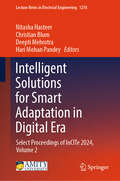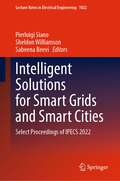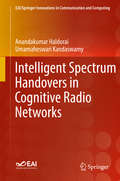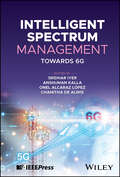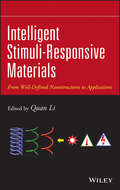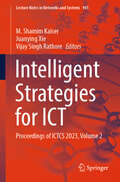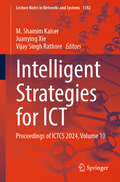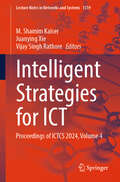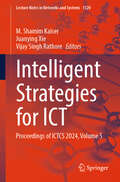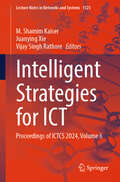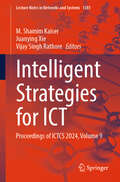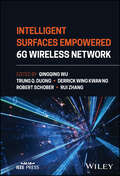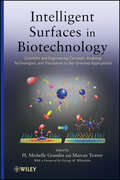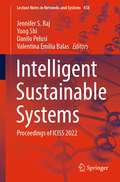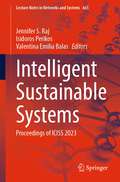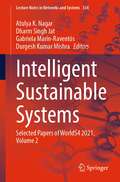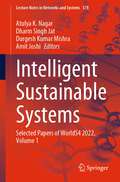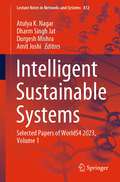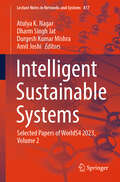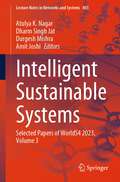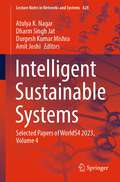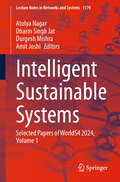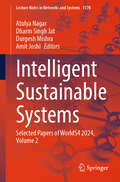- Table View
- List View
Intelligent Solutions for Smart Adaptation in Digital Era: Select Proceedings of InCITe 2024, Volume 2 (Lecture Notes in Electrical Engineering #1278)
by Christian Blum Hari Mohan Pandey Nitasha Hasteer Deepti MehrotraThis book comprises the select peer-reviewed proceedings of the 4th International Conference on Information Technology (InCITe-2024). It aims to provide a comprehensive knowledge base highlighting state-of-the-art research and development and best practices for intelligent solutions in the digital era. It covers adaptive intelligence, decision intelligence, artificial intelligence, deep learning, machine learning, data science, and enabling technologies for IoT, blockchain, and other futuristic technologies. The content would serve as a rich knowledge repository on information & communication technologies, neural networks, fuzzy systems, natural language processing, data mining & warehousing, big data analytics, cloud computing, social networks and intelligence, decision-making, and modeling, information systems, IT architectures, and security related aspects. This book provides a valuable resource for those in academia and industry.
Intelligent Solutions for Smart Grids and Smart Cities: Select Proceedings of IPECS 2022 (Lecture Notes in Electrical Engineering #1022)
by Pierluigi Siano Sheldon Williamson Sabeena BeeviThis book comprises the select proceedings of the International Conference in Power, Energy, Control, Signals and Systems (IPECS) 2022. The book focuses on intelligent solutions for smart grids and smart cities. The content of this book is designed to develop many innovative ideas for an energy-efficient and sustainable future. It focuses on recent technological advances and challenges in the field of grid integration of renewable energy resources, AI/ML in power and energy systems, security enhancement of power systems/electronics using advanced ML techniques for integration of renewable energies, electric vehicle-energy storage, and battery charging technologies, etc. The book also covers the latest advances especially in instrumentation and control in smart grid applications —Internet of Things and cyber-physical systems, power semiconductor device technology leading to improvements in power losses for power electronic systems, economic and sustainable design of smart cities-security and data privacy in smart cities, lighting, and illumination. This book proves to be a valuable resource for those in academia and industry.
Intelligent Spectrum Handovers in Cognitive Radio Networks (EAI/Springer Innovations in Communication and Computing)
by Anandakumar Haldorai Umamaheswari KandaswamyThis book highlights the need for an efficient Handover Decision (HD) mechanism to perform switches from one network to another and to provide unified and continuous mobile services that include seamless connectivity and ubiquitous service access. The author shows how the HD involves efficiently combining handover initiation and network selection process. The author describes how the network selection decision is a challenging task that is a central component to making HD for any mobile user in a heterogeneous environment that involves a number of static and dynamic parameters. The author also discusses prevailing technical challenges like Dynamic Spectrum Allocation (DSA) methods, spectrum sensing, cooperative communications, cognitive network architecture protocol design, cognitive network security challenges and dynamic adaptation algorithms for cognitive system and the evolving behavior of systems in general. The book allows the reader to optimize the sensing time for maximizing the spectrum utilization, improve the lifetime of the cognitive radio network (CRN) using active scan spectrum sensing techniques, analyze energy efficiency of CRN, find a secondary user spectrum allocation, perform dynamic handovers, and use efficient data communication in the cognitive networks.Identifies energy efficient spectrum sensing techniques for Cooperative Cognitive Radio Networks (CRN);Shows how to maximize the energy capacity by minimizing the outage probability;Features end-of-chapter summaries, performance measures, and case studies.
Intelligent Spectrum Management: Towards 6G
by Sridhar Iyer Anshuman Kalla Onel Alcaraz López Chamitha De AlwisForward-thinking reference on spectrum sharing and resource management for 5G, B5G, and 6G wireless networks Intelligent Spectrum Management: Towards 6G explores various aspects of spectrum sharing and resource management in 5G, beyond 5G, and the envisaged 6G networks. The book offers an in-depth exploration of intelligent and secure sharing of spectrum and resource management in existing and future mobile networks. The book sets the stage by providing an insight to the evolution of mobile networks and highlights the importance of spectrum sharing and resource management in next-generation wireless networks. At the core, the book explores various promising technologies such as cognitive radio, reinforcement learning, deep learning, reconfigurable intelligent surfaces, and blockchain technology towards efficient, intelligent, and secure sharing of spectrum and resource management. Moreover, the book presents dynamic and decentralized resource management techniques, including network slicing, game theory, and blockchain-enabled approaches. Topics covered include: Spectrum, and why it must be utilized optimally and transparentlyFuture applications envisioned with 6G, such as digital twins, Industry 5.0, holographic telepresence, and Extended Reality (XR)Challenges when Dynamic Spectrum Management (DSM) is enabled through Machine Learning (ML) techniques, including the complexity of received signals and the difficulty in obtaining accurate network data such as channel state informationReinforcement learning and deep learning-assisted spectrum management Synergy between Artificial Intelligence (AI) and blockchain technology for spectrum managementPrivate networks, including their prospects, architecture, enabling concepts, and techniques for efficient operation In essence, various innovative technologies and approaches that can be leveraged to enhance spectrum utilization and efficiently manage network resources are discussed. The book is a potential reference for researchers, academics, and professionals in the wireless service provider industry, as well as regulators and officials.
Intelligent Stimuli-Responsive Materials
by Quan LiThere has been concerted effort across scientific disciplines to develop artificial materials and systems that can help researchers understand natural stimuli-responsive activities. With its up-to-date coverage on intelligent stimuli-responsive materials, Intelligent Stimuli-Responsive Materials provides research, industry, and academia professionals with the fundamentals and principles of intelligent stimuli-responsive materials, with a focus on methods and applications. Emphasizing nanostructures and applications for a broad range of fields, each chapter comprehensively covers a different stimuli-responsive material and discusses its developments, advances, challenges, analytical techniques, and applications.
Intelligent Strategies for ICT: Proceedings of ICTCS 2023, Volume 2 (Lecture Notes in Networks and Systems #941)
by Vijay Singh Rathore M. Shamim Kaiser Juanying XieThis book contains best selected research papers presented at ICTCS 2023: Eighth International Conference on Information and Communication Technology for Competitive Strategies. The conference was held in Jaipur, India during 8 – 9 December 2023. The book covers state-of-the-art as well as emerging topics pertaining to ICT and effective strategies for its implementation for engineering and managerial applications. This book contains papers mainly focused on ICT for computation, algorithms and data analytics and IT security. The work is presented in three volumes.
Intelligent Strategies for ICT: Proceedings of ICTCS 2024, Volume 10 (Lecture Notes in Networks and Systems #1382)
by Vijay Singh Rathore M. Shamim Kaiser Juanying XieThis book contains best selected research papers presented at ICTCS 2024: Ninth International Conference on Information and Communication Technology for Competitive Strategies. The conference will be held in Jaipur, India during 19 – 21 December 2024. The book covers state-of-the-art as well as emerging topics pertaining to ICT and effective strategies for its implementation for engineering and managerial applications. This book contains papers mainly focused on ICT for computation, algorithms and data analytics and IT security. The work is presented in ten volumes.
Intelligent Strategies for ICT: Proceedings of ICTCS 2024, Volume 4 (Lecture Notes in Networks and Systems #1319)
by Vijay Singh Rathore M. Shamim Kaiser Juanying XieThis book contains best selected research papers presented at ICTCS 2024: Ninth International Conference on Information and Communication Technology for Competitive Strategies. The conference will be held in Jaipur, India during 19 – 21 December 2024. The book covers state-of-the-art as well as emerging topics pertaining to ICT and effective strategies for its implementation for engineering and managerial applications. This book contains papers mainly focused on ICT for computation, algorithms and data analytics and IT security. The work is presented in ten volumes.
Intelligent Strategies for ICT: Proceedings of ICTCS 2024, Volume 5 (Lecture Notes in Networks and Systems #1320)
by Vijay Singh Rathore M. Shamim Kaiser Juanying XieThis book contains best selected research papers presented at ICTCS 2024: Ninth International Conference on Information and Communication Technology for Competitive Strategies. The conference will be held in Jaipur, India during 19 – 21 December 2024. The book covers state-of-the-art as well as emerging topics pertaining to ICT and effective strategies for its implementation for engineering and managerial applications. This book contains papers mainly focused on ICT for computation, algorithms and data analytics and IT security. The work is presented in ten volumes.
Intelligent Strategies for ICT: Proceedings of ICTCS 2024, Volume 6 (Lecture Notes in Networks and Systems #1321)
by Vijay Singh Rathore M. Shamim Kaiser Juanying XieThis book contains best selected research papers presented at ICTCS 2024: Ninth International Conference on Information and Communication Technology for Competitive Strategies. The conference will be held in Jaipur, India during 19 – 21 December 2024. The book covers state-of-the-art as well as emerging topics pertaining to ICT and effective strategies for its implementation for engineering and managerial applications. This book contains papers mainly focused on ICT for computation, algorithms and data analytics and IT security. The work is presented in ten volumes.
Intelligent Strategies for ICT: Proceedings of ICTCS 2024, Volume 9 (Lecture Notes in Networks and Systems #1381)
by Vijay Singh Rathore M. Shamim Kaiser Juanying XieThis book contains best selected research papers presented at ICTCS 2024: Ninth International Conference on Information and Communication Technology for Competitive Strategies. The conference will be held in Jaipur, India during 19 – 21 December 2024. The book covers state-of-the-art as well as emerging topics pertaining to ICT and effective strategies for its implementation for engineering and managerial applications. This book contains papers mainly focused on ICT for computation, algorithms and data analytics and IT security. The work is presented in ten volumes.
Intelligent Surfaces Empowered 6G Wireless Network
by Robert Schober Derrick Wing Kwan Ng Trung Q. Duong Rui Zhang Qingqing WuINTELLIGENT SURFACES EMPOWERED 6G WIRELESS NETWORK Integrate intelligent surfaces into the wireless networks of the future. The next generation of wireless technology (6G) promises to transform wireless communication and human interconnectivity like never before. Intelligent surface, which adopts significant numbers of small reflective surfaces to reconfigure wireless connections and improve network performance, has recently been recognized as a critical component for enabling future 6G. The next phase of wireless technology demands engineers and researchers are familiar with this technology and are able to cope with the challenges. Intelligent Surfaces Empowered 6G Wireless Network provides a thorough overview of intelligent surface technologies and their applications in wireless networks and 6G. It includes an introduction to the fundamentals of intelligent surfaces, before moving to more advanced content for engineers who understand them and look to apply them in the 6G realm. Its detailed discussion of the challenges and opportunities posed by intelligent surfaces empowered wireless networks makes it the first work of its kind. Intelligent Surfaces Empowered 6G Wireless Network readers will also find: An editorial team including the original pioneers of intelligent surface technology. Detailed coverage of subjects including MIMO, terahertz, NOMA, energy harvesting, physical layer security, computing, sensing, machine learning, and more. Discussion of hardware design, signal processing techniques, and other critical aspects of IRS engineering. Intelligent Surfaces Empowered 6G Wireless Network is a must for students, researchers, and working engineers looking to understand this vital aspect of the coming 6G revolution.
Intelligent Surfaces in Biotechnology
by H. Michelle Grandin Marcus TextorA comprehensive overview of smart and responsive surfaces in biotechnology and their applications A wave of recent advances in cell biology, biophysics, chemistry, and materials science has enabled the development of a new generation of smart biomaterials. Intelligent Surfaces in Biotechnology: Scientific and Engineering Concepts, Enabling Technologies, and Translation to Bio-Oriented Applications provides readers with a comprehensive overview of surface modifications and their applications, including coverage of the physico-chemical properties, characterization methods, smart coating technologies, and demonstration of performance in vitro and in vivo. The first part of the book covers applications in the fields of biosensing and biodiagnostics, while the second part focuses more on coatings for medical devices, drug delivery, and tailored cell-surface interactions. The book explores intelligent surface applications such as tissue engineering, drug targeting and delivery, wound healing and anti-infection strategies, biosensors, nanopatterning, and bioinspired design of novel responsive materials and multifunctional surfaces. Designed to aid scientists and engineers in understanding the rapidly developing field of biofunctional surfaces, Intelligent Surfaces in Biotechnology is an edited volume with each chapter written by a respected expert and featuring examples taken from the most state-of-the-art developments in the discipline. Cover Image: Design concept for a diagnostic microfluidic system based on responsive polymer- and antibody-conjugated nanobeads (see Chapter 2 of this book, Figure 2. 5; reproduced by permission from the Royal Society of Chemistry).
Intelligent Sustainable Systems: Proceedings of ICISS 2021 (Lecture Notes in Networks and Systems #213)
by Yong Shi Ram Palanisamy Isidoros Perikos Jennifer S. RajThis book features research papers presented at the 4th International Conference on Intelligent Sustainable Systems (ICISS 2021), held at SCAD College of Engineering and Technology, Tirunelveli, Tamil Nadu, India, during February 26–27, 2021. The book discusses the latest research works that discuss the tools, methodologies, practices, and applications of sustainable systems and computational intelligence methodologies. The book is beneficial for readers from both academia and industry.
Intelligent Sustainable Systems: Proceedings of ICISS 2022 (Lecture Notes in Networks and Systems #458)
by Yong Shi Valentina Emilia Balas Danilo Pelusi Jennifer S. RajThis book features research papers presented at the 5th International Conference on Intelligent Sustainable Systems (ICISS 2022), held at SCAD College of Engineering and Technology, Tirunelveli, Tamil Nadu, India, during February 17–18, 2022. The book discusses latest research works that discusses the tools, methodologies, practices, and applications of sustainable systems and computational intelligence methodologies. The book is beneficial for readers from both academia and industry.
Intelligent Sustainable Systems: Proceedings of ICISS 2023 (Lecture Notes in Networks and Systems #665)
by Valentina Emilia Balas Isidoros Perikos Jennifer S. RajThis book features research papers presented at the 6th International Conference on Intelligent Sustainable Systems (ICISS 2023), held at SCAD College of Engineering and Technology, Tirunelveli, Tamil Nadu, India, during February 2–3, 2023. The book reports research results on the development and implementation of novel systems, technologies, and applications that focus on the advancement of sustainable living. The chapters included in this book discuss a spectrum of related research issues such as applications of intelligent computing practices that can have ecological and societal impacts. Moreover, this book emphasizes on the state-of-the-art networked and intelligent technologies that are influencing a promising development in the direction of a long-term sustainable future. The book is beneficial for readers from both academia and industry.
Intelligent Sustainable Systems: Selected Papers of WorldS4 2021, Volume 1 (Lecture Notes in Networks and Systems #333)
by Durgesh Kumar Mishra Atulya K. Nagar Dharm Singh Jat Gabriela Marín-RaventósThis book provides insights of World Conference on Smart Trends in Systems, Security and Sustainability (WS4 2021) which is divided into different sections such as Smart IT Infrastructure for Sustainable Society; Smart Management prospective for Sustainable Society; Smart Secure Systems for Next Generation Technologies; Smart Trends for Computational Graphics and Image Modeling; and Smart Trends for Biomedical and Health Informatics. The proceedings is presented in two volumes. The book is helpful for active researchers and practitioners in the field.
Intelligent Sustainable Systems: Selected Papers of WorldS4 2021, Volume 2 (Lecture Notes in Networks and Systems #334)
by Durgesh Kumar Mishra Atulya K. Nagar Dharm Singh Jat Gabriela Marín-RaventósThis book provides insights of World Conference on Smart Trends in Systems, Security and Sustainability (WS4 2021) which is divided into different sections such as Smart IT Infrastructure for Sustainable Society; Smart Management prospective for Sustainable Society; Smart Secure Systems for Next Generation Technologies; Smart Trends for Computational Graphics and Image Modeling; and Smart Trends for Biomedical and Health Informatics. The proceedings is presented in two volumes. The book is helpful for active researchers and practitioners in the field.
Intelligent Sustainable Systems: Selected Papers of WorldS4 2022, Volume 1 (Lecture Notes in Networks and Systems #578)
by Amit Joshi Durgesh Kumar Mishra Atulya K. Nagar Dharm Singh JatThis book provides insights of World Conference on Smart Trends in Systems, Security and Sustainability (WS4 2022) which is divided into different sections such as Smart IT Infrastructure for Sustainable Society; Smart Management Prospective for Sustainable Society; Smart Secure Systems for Next Generation Technologies; Smart Trends for Computational Graphics and Image Modeling; and Smart Trends for Biomedical and Health Informatics. The proceedings is presented in two volumes. The book is helpful for active researchers and practitioners in the field.
Intelligent Sustainable Systems: Selected Papers of WorldS4 2023, Volume 1 (Lecture Notes in Networks and Systems #812)
by Amit Joshi Atulya K. Nagar Dharm Singh Jat Durgesh MishraThis book provides insights of World Conference on Smart Trends in Systems, Security and Sustainability (WS4 2023) which is divided into different sections such as Smart IT Infrastructure for Sustainable Society; Smart Management Prospective for Sustainable Society; Smart Secure Systems for Next Generation Technologies; Smart Trends for Computational Graphics and Image Modeling; and Smart Trends for Biomedical and Health Informatics. The proceedings is presented in four volumes. The book is helpful for active researchers and practitioners in the field.
Intelligent Sustainable Systems: Selected Papers of WorldS4 2023, Volume 2 (Lecture Notes in Networks and Systems #817)
by Amit Joshi Durgesh Kumar Mishra Atulya K. Nagar Dharm Singh JatThis book provides insights of World Conference on Smart Trends in Systems, Security and Sustainability (WS4 2023) which is divided into different sections such as Smart IT Infrastructure for Sustainable Society; Smart Management Prospective for Sustainable Society; Smart Secure Systems for Next Generation Technologies; Smart Trends for Computational Graphics and Image Modeling; and Smart Trends for Biomedical and Health Informatics. The proceedings is presented in two volumes. The book is helpful for active researchers and practitioners in the field.
Intelligent Sustainable Systems: Selected Papers of WorldS4 2023, Volume 3 (Lecture Notes in Networks and Systems #803)
by Amit Joshi Atulya K. Nagar Dharm Singh Jat Durgesh MishraThis book provides insights of World Conference on Smart Trends in Systems, Security, and Sustainability (WS4 2023) which is divided into different sections such as Smart IT Infrastructure for Sustainable Society; Smart Management Prospective for Sustainable Society; Smart Secure Systems for Next Generation Technologies; Smart Trends for Computational Graphics and Image Modeling; and Smart Trends for Biomedical and Health Informatics. The proceedings is presented in two volumes. The book is helpful for active researchers and practitioners in the field.
Intelligent Sustainable Systems: Selected Papers of WorldS4 2023, Volume 4 (Lecture Notes in Networks and Systems #828)
by Amit Joshi Durgesh Kumar Mishra Atulya K. Nagar Dharm Singh JatThis book provides insights of World Conference on Smart Trends in Systems, Security and Sustainability (WS4 2023) which is divided into different sections such as Smart IT Infrastructure for Sustainable Society; Smart Management Prospective for Sustainable Society; Smart Secure Systems for Next Generation Technologies; Smart Trends for Computational Graphics and Image Modeling; and Smart Trends for Biomedical and Health Informatics. The proceedings is presented in four volumes. The book is helpful for active researchers and practitioners in the field.
Intelligent Sustainable Systems: Selected Papers of WorldS4 2024, Volume 1 (Lecture Notes in Networks and Systems #1179)
by Atulya Nagar Amit Joshi Dharm Singh Jat Durgesh MishraThis book provides insights of World Conference on Smart Trends in Systems, Security and Sustainability (WS4 2024) which is divided into different sections such as Smart IT Infrastructure for Sustainable Society; Smart Management Prospective for Sustainable Society; Smart Secure Systems for Next Generation Technologies; Smart Trends for Computational Graphics and Image Modeling; and Smart Trends for Biomedical and Health Informatics. The proceedings is presented in four volumes. The book is helpful for active researchers and practitioners in the field.
Intelligent Sustainable Systems: Selected Papers of WorldS4 2024, Volume 2 (Lecture Notes in Networks and Systems #1178)
by Atulya Nagar Amit Joshi Dharm Singh Jat Durgesh MishraThis book provides insights of World Conference on Smart Trends in Systems, Security and Sustainability (WS4 2024) which is divided into different sections such as Smart IT Infrastructure for Sustainable Society; Smart Management Prospective for Sustainable Society; Smart Secure Systems for Next Generation Technologies; Smart Trends for Computational Graphics and Image Modeling; and Smart Trends for Biomedical and Health Informatics. The proceedings is presented in four volumes. The book is helpful for active researchers and practitioners in the field.
